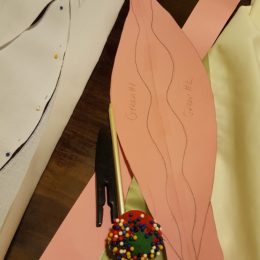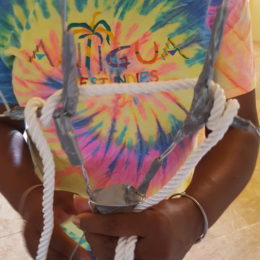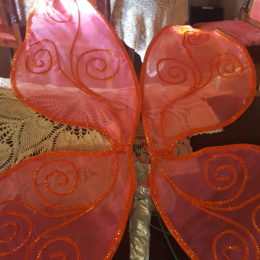∞
—
The first mas I remember was Dynamics, Fire on Ice, 1976. By the calendar, I would have been three years old at that time. I remember the troupe coming up High Street, red flames licking across silver-white back pieces. Dynamics won band of the year, one of many as it would turn out over the years, but I probably remember it mostly because my mom played mas that year. My mom being in de Carnival wasn’t unusual. Some of my earliest memories are of her leaving for the Calypso show on Sunday night and Tanty waking me and my sister up foreday morning, Monday, for when my mom would come get us to go jump in the j’ouvert. How she managed to wrangle two girls in the madness and music that was j’ouvert, I don’t know. I’ve only missed one Carnival in my life, and though I was off exploring Europe and the Mediterranean at the time – trip of a lifetime, right – missing it ached. That’s my mother’s doing. Still, Fire on Ice (or, as I called it all these years before researching the band of the year winning presentation for this reflection, Fire and Ice), aside, this is my only vivid memory of my mom playing mas. Of course, it’s also possible that I don’t remember my mom playing mas that year, at all, in real time, I don’t remember much from that time. Perhaps I saw a picture of her in her costume at some later date and wrote a memory to fit. It feels like a first-hand memory though. Memory or make-up, it captured my imagination and hasn’t let it go since.
I’ve referred to mas as some of my earliest exposures to theatre and storytelling. I especially enjoyed the huge King and Queen of the Band costumes which have largely disappeared from Antiguan mas but which, after showing off on the stage, would take up the whole of Market Street as the parade inched along. The younger ones lobbying for Carnival to be moved from the city to the wider, less cramped, safer spaces on its outskirts can’t imagine how intimate and joyful that feeling was. We would sing the calypso, dance to the soca, and as the costumes floated by, or were dragged or carried by revelers who, despite their size and presumed weightiness, seemed buoyed rather than burdened by them, our eyes would open wide at their grandeur. They were shiny and colourful, a moving canvas; big and bold, inventive and daring. The costumes designed by Heather Doram, still one of Antigua’s finest artists, and built by her husband Connie Doram, come to mind – this would have been later, I think, in my pre-teens, during the costume segment of the Queen Show. Time bends in memory. The when isn’t important, just that it was all mas, and that mas at its best was like visiting the L’ouvre in France or the Museum of Modern Art in New York; only it was our art, from arwe imagination, telling our stories, and it was beautiful, and powerful, and magical. Of course, I wasn’t thinking all of that back then, not at three or thirteen. Back then it was just a feeling that exploded in my body like fireworks. That’s what mas is at its purest, that feeling: pure joy.
I would capture that feeling from the inside for the first time the first time I played mas in 1989.
I was a majorette before that, as a kid. It involved practices at which we were drilled to precision – I can still twirl a baton like a pro (or at least as well as I could back then). But the thing I remember of the road is being relieved when I spied my mother in the crowd on that same High Street and could signal to her that I was thirsty.
That’s a fundamental difference.
Playing mas, for me at least, is so immersive that your body transcends its usual needs – you can drink to heighten the experience, sure, but your body has no needs to ingest or eject anything for those hours on the road. The point is though, weariness, all that, you’ll feel it when the music stops, and not a moment before. I lost the soles of a perfectly good pair of shoes to mas and last lap one year and didn’t notice until the music stopped. One year, late 1990s, I discovered when I removed my costume that I had picked up a discernable tan for the first time in my beach going life as a dark-skinned sister, from the sheer number of hours we spent on the road. Xtreme, the troupe I played with that year, my first year not playing with Dynamics, was a forerunner in the introduction of the all-inclusive, extended mas to Antigua. The mas started in town hours before the actual parade then running, jumping, and wining through several residential communities before joining the official parade. It was the first time I was with a troupe where the costume was secondary to the party.
But my first year, 1989, incidentally the year I graduated secondary school, and for many of the years after, I played with Dynamics. Dynamics was designed by Errol ‘Bumpy’ Nanton who topically over the years has explored everything from historical Mayan culture to, at the time, contemporary, Desert Storm – i.e. the first war in Iraq. These were the days when Dynamics partnered with Burning Flames, the Antiguan jam band that changed up the rhythm in Antigua and beyond beginning in the mid-1980s, and which had a Pied Piper like effect on the crowd from year one’s Stylie Tight. I remember the way we would go crazy when we hit those judging points, like right where Market Street curves in to Newgate Street, an expansive space that allowed us to spread out and go wild even as the band leaders hustled to keep us in some kind of order to properly present the costume. They were about telling a story, and the best storyteller took home boasting rights.
Back then, the stage at Carnival City was very different from how it is now. There was a huge mural-like backdrop between the front and back of stage. After we did our first run across the stage, we’d circle back to the back of stage in a narrow alley between that mural and, I’m assuming changing rooms or some such, waiting our turn for one last lap across the stage. That space was dark and the stamping of eager feet and standards was comparable only to the way the music beat loud in your chest Saturday afternoons at Jam Pond where Flames held court, and where with the riddim box and a “we gotta go now”, we lost not only our minds but control over our bodies. It was that feeling, a feeling you want to jump in to and stay in forever. And when we burst from that place in the dark, behind the stage, where our feet and hearts beat loudly in tandem, we would be like race horses breaking out of the gates and hitting the stage and never wanting to leave; that can-I-keep-this-forever feeling.
It’s the best feeling in the world, and that was mas.
That part of mas is still there. The numbers continue to grow even as the prices continue to rise, but the other thing continues to slip away.
Mas is no longer theatre. That’s not just nostalgia. What is now referred to as traditional mas has exited the scene for the most part, even as a new breed of revelers storm the stage. One of the traditionalists once described this new show as “selfish” mas. I don’t know if I’d go so far but I did take from what he said that there was a sense before the party bands took over, that the mas was theatre the spectators came to see, and both had an awareness and acceptance of their role. Observing the modern reveler, you might feel more like a voyeur observing the barely there costumes and bedroom behaviour. Not knocking it, but it has gotten wilder. Maybe that is nostalgia after all. Point is, those of us who’ve been both in the mas and outside observing the mas do feel a shift. I’ve played with no less than four troupes, mostly Dynamics, over the years, but also Revellers, another multi-award winner, and the first year of Solid. I’ve also covered a lot of the Carnivals, and mas, describing the concepts, getting a first look at the drawings. These days, no matter what’s on the page, on the road, it’s mostly bikinis, and near impossible to tell this feathered headpiece from that, and much as it still thrills me, in whatever incarnation, I do miss the days when mas was more Broadway and less Vegas. Vegas is fun, but I do miss the days when it was like opening a storybook .Like Alice in Wonderland with its parade of colourful characters and dreamlike quality.
In 2017, I decided to return to mas after a few years, taking a story of my own to the road.
I wrote a book called With Grace which was published in December 2016. The book is a Caribbean fairytale which tells of a girl who, in trying to get a mango tree to bear, awakens a tree faerie. While recovering from a medical issue early in 2017, I became obsessed with seeing this faerie, described as a “magical creature that looks like nothing more than a mango blossom”, on the road. It hastened my recovery, I think, and had me anticipating Carnival like I hadn’t in a long time. Fortunately I had a couple of friends with mas building experience. They’d been off the road for a couple of years as well, their troupe being one of the last non-party bands to hang up their glue guns. Both had been friends since my school days, and one of them had been my mas buddy throughout most of my Dynamics years. I was still on bed rest when I sent her an image of the faerie from the book, illustrated by Barbadian artist Cherise Harris. She was not only game but eager.
I’d never been involved in the mas management side of things before; it’s not as easy on the mind. My friends did the mas building – bending wire for the wings, shaping, cutting, and gluing on the sparkly touches. I handled the boring bureaucracy.
I had to write our mas description for the stage. After many drafts, we ended up with this description of “With Grace: a Caribbean Fairytale”, as presented by Grace’s Merrymakers. That’s what we called ourselves.
According to this story, the tree faerie is the spirit that lives in every tree, encouraging it to grow. This particular mango tree, stripped by the elements, has been asleep for some time. Until one day, the tree faerie, lured by music and positive energy, awakens – the intoxicating and joyful pull of the calypso-like song too alluring to resist. And as the faerie comes back to life so does the tree, bearing mangoes for everybody. The tree faerie, the mango tree, the singing girl whose music awakens them both, are all characters in the Caribbean fairytale, With Grace, a children’s picture book by Antiguan and Barbudan author Joanne C. Hillhouse. We’ve seen cartoons and storybook characters from other places in the Carnival but how often do we get to see one from our own imagination, one of our own? Well, the tree faerie is here to put her stamp on Carnival City. Inspired by illustrations created by Cherise Harris for the book With Grace by Joanne C. Hillhouse, meet the tree faerie, built and presented by Grace’s Merry Makers, Helena Jeffery Brown and Augusta Scotland Samuel. The faerie’s bodice is the colour of tree bark crisscrossed in green. Her skirt consists of green leaves, with stripes of gold, hanging from her body like leaves from a tree. Look closely, you’ll also see mango blossoms – between the faerie’s wings, pinned into her hair, and along the leaves making up her hand pieces. The faerie’s wings spread wide as she wakes, the orange pink hue of a ripening mango, made of bent wire in the tradition of Antiguan mas. Another feature of local mas, the standards – poles wrapped in leaves, in hues of green and gold – are the trees waving in the breeze. It’s mango season, Carnival season, a season of creativity in full bloom. With Grace: A Caribbean Fairytale is a homegrown display made possible with sponsorship from Townhouse Mega Store on All Saints Road, Titi’s Rent-a-Car in English Harbour, and Pink Mongoose in St. John’s City. “Waking up, as if to a new world, both tree and [faerie] are finding that they like the way the sun’s burn feels more like kisses, the way the sharp sea breeze invigorates.” Watch her wings flutter as she breathes in love and music, as she springs to life, looking “like nothing more than a mango blossom” – the gold and green of new beginnings, hinting at the orange sweetness to come, it’s the tree faerie, With Grace!
It was way too long. Which we realised with growing impatience – impatience eclipsed only by the troupe behind us, already miffed that our micro-mas got to go ahead of them – as we waited in the wings to storm the stage. That’s right we were the first mas band to hit the stage at Carnival City on the first day of our two-day parade, Carnival Monday. This was due to us being the first group to show up. Hey, they told us what time to be there since we had no mas camp, no route, no band, and barely managed to hang on to our banner holders. We were there on time, which is to say, too early; translation: a lot of waiting around. But here’s the thing about mas, once you hit the stage, you forget about all that; and it didn’t matter that we were laughably small – so small one radio commentator couldn’t stop saying “all three of them” with something like amusement and bemusement in his voice. Claudette Peters sang “Out Dey!”, the song that would go on to win her her first and long overdue road march title, and we danced.
When my friend suggested after we left the stage that I needed to shorten the intro, I tuned her out, deciding to be done with the stressing and get with the mas playing. Tomorrow was Carnival Tuesday and wey e drap e tap. Carnival Tuesday decided to test that resolve in all kinds of ways – a true comedy of errors – picture us overcompensating on the other side of the clock after waiting around so much the previous day and missing the start of the parade, with nobody around to tell us where we slotted in – information I’d tried in vain to get for weeks before, picture our banner holders missing in action then racing to find us, then ditching us, then finding us then ditching us again, picture us kotching a spot in the parade… and just deciding to go with it.
Until we got to the grounds and needed banner holders all over again in order to hit the stage. Thanks to the little girl who was so eager to fill in; now we are part of her early mas memory.
It thrilled me to be able to showcase one of my stories in the Carnival: a full circle experience, considering that Carnival and mas introduced me to stories. It thrilled me, as much as my fairytale itself does, to be able to present to our children some reflection of self, even in fantasy, even in the magical phantasm that is Carnival. Carnival is that time outside of time, outside of the grind, outside of reality, that allows us to Expose – to reference a soca classic by Antigua and Barbuda’s own Tizzy and El A Kru classic – our culture, our spirit, our energy, our creativity, and, for those who take it all too literally, other things. Mas is an opportunity to slip in to a character, be outside of yourself in a wholly liberating way.
It’s easier to do that, of course, I’ve found if you’re not actually responsible for a mas even if it is just a mas of three.
∞
Joanne C. Hillhouse has written six books – The Boy from Willow Bend, Dancing Nude in the Moonlight, Oh Gad!, Musical Youth, With Grace, and Lost! A Caribbean Sea Adventure. She freelances as a writer, editor, writing coach, and course/workshop facilitator. Her main volunteer project is the Wadadli Youth Pen Prize (wadadlipen.wordpress.com) to nurture and showcase the literary arts in Antigua and Barbuda.





